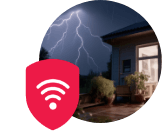How to Get Internet without a Phone Line or Cable
Table of Contents
These days, internet access is practically a necessity. However, traditional methods of getting online through phone lines (DSL) or cable connections aren’t available to everyone. Whether you live in a rural area without the necessary infrastructure, you’re trying to avoid bundle packages, or you simply want more flexibility, there are still several ways to get reliable internet without depending on conventional phone lines or cable services. This guide explores the four primary alternatives to traditional internet services: fixed wireless, 4G and 5G home internet, mobile hotspots, and satellite internet. We’ll take a look at how each option works, its typical speeds, costs, and which situations it works best for.
What Is Fixed Wireless Internet?
Fixed wireless internet uses radio signals transmitted from a ground station to a receiver installed at your home [1]. Unlike satellite internet that beams signals from space, fixed wireless relies on nearby transmission towers, typically within 10 miles of your location. Fixed wireless is a great option for rural and suburban areas where DSL or cable isn’t available but there’s a wireless ISP (WISP) tower nearby. It’s a solid middle-ground choice—more reliable than satellite internet and with better coverage than cellular options.
How Fixed Wireless Works
A technician installs a small dish or antenna on your property, usually on the roof or exterior wall with a clear line of sight to the provider’s tower. This receiver connects to a router inside your home, distributing internet throughout your living space just like traditional connections.
Typical Speeds and Pricing
- Speed Range: 5-100 Mbps (though some newer providers offer speeds up to 1 Gbps in select areas)
- Monthly Cost: $40-$100
- Installation Fees: $100-$300 (sometimes waived with contracts)
- Data Caps: Varies by provider; many offer unlimited data options

4G and 5G Home Internet: Cellular-Powered Connectivity
This type of internet service uses the same cellular networks that power your smartphone but is designed specifically for home use. Unlike mobile hotspots, these services come with dedicated equipment that enhances signal strength and provides more stable connections. [2]
How 4G/5G Home Internet Works
Providers supply a specialized router that connects to nearby cell towers. The router picks up cellular signals and converts them into a Wi-Fi network for your home. Unlike mobile hotspots, these systems typically include external antennas or signal boosters for improved performance. Cellular home internet works well for households with moderate internet usage in areas with strong cellular coverage. It’s particularly valuable for those who need a quick setup without installation appointments or as a temporary solution while waiting for other services.
Typical Speeds and Pricing
- 4G Speeds: 25-100 Mbps download, 10-50 Mbps upload
- 5G Speeds: 40-300 Mbps download, 10-50 Mbps upload
- Monthly Cost: $35-$70
- Equipment: Usually included or available for a monthly fee of $5-$15
- Data Caps: Often higher than mobile plans (100GB-500GB) or unlimited with potential speed reduction after certain thresholds

Mobile Hotspots: Internet On The Go
Mobile hotspots are portable devices that create small Wi-Fi networks by connecting to cellular data networks. They can be dedicated devices purchased from cellular providers or functionality built into smartphones.
How Mobile Hotspots Work
A hotspot device connects to nearby cell towers and creates a private Wi-Fi network that multiple devices can join. Smartphone hotspots work similarly but use your phone’s cellular connection to create the network. [3] Mobile hotspots are great for travelers, remote workers on the move, or as a backup for your internet. That said, they’re not the best option for primary home internet because of data limits and possible speed issues.
Typical Speeds and Pricing
- Speeds: Speeds are highly dependent on cellular coverage and network congestion
- Device Cost: $50-$200 for dedicated devices (often discounted with service plans)
- Monthly Service: $15-$80 depending on data allowance
- Data Caps: Usually limited to 10 GB per month before significant slowdowns [4]

Satellite Internet: Available Almost Everywhere
Satellite internet provides connectivity by communicating with orbiting satellites rather than ground-based infrastructure. This technology can deliver internet service to virtually any location with a clear view of the sky.
How Satellite Internet Works
A dish installed on your property sends and receives signals to and from satellites orbiting the Earth. These signals are relayed to ground stations connected to the internet backbone. The setup includes a modem and router inside your home to distribute the connection. Traditional satellite internet works best for rural areas where there aren’t other options. LEO satellite services like Starlink offer a much better experience and can even be a primary connection for high-demand users in remote spots.
Traditional vs. Low Earth Orbit (LEO) Satellite Internet
Traditional satellite internet providers like HughesNet and Viasat rely on geostationary satellites sitting about 22,000 miles above Earth. This distance leads to high latency (600-800ms), which isn’t great for things like video calls or online gaming. Newer services like Starlink, on the other hand, use low Earth orbit (LEO) satellites that fly much closer—around 340 miles above Earth. This means way lower latency (20-40ms) and much faster speeds, making it feel a lot more like regular wired broadband. [6]
Typical Speeds and Pricing
Traditional Satellite (HughesNet, Viasat):
- Speeds: 12-100 Mbps download, 3-5 Mbps upload
- Monthly Cost: $60-$150
- Equipment: $300-$500 (often with options to lease)
- Data Caps: 10-150GB priority data (service slowed significantly after cap)
Low Earth Orbit (Starlink):
- Speeds: 50-250 Mbps download, 10-20 Mbps upload
- Monthly Cost: $110-$120
- Equipment: $599-$699 (purchase required)
- Data Caps: Typically unlimited with fair use policies

How to Choose the Right Option for Your Needs
When choosing an internet option without a phone line or cable, keep these things in mind:
1. Availability in Your Area
- Fixed wireless requires proximity to a provider’s tower
- 4G/5G home internet needs strong cellular coverage
- Satellite internet requires a clear view of the sky (and specific directions for traditional satellite)
2. Your Internet Usage Patterns
- Light users (email, web browsing) can work with any option
- Video streamers should look for services with higher data caps or unlimited options
- Remote workers/gamers should prioritize lower latency services like fixed wireless or LEO satellite
- Multiple-user households need higher bandwidth options and larger/unlimited data allowances
3. Budget Considerations
- Equipment costs: Satellite often has the highest upfront costs
- Monthly fees: Consider promotional rates vs. standard pricing
- Contract requirements: Some services offer lower rates with 1-2 year commitments
4. Installation Requirements
- DIY setup: 4G/5G home internet and mobile hotspots are usually self-install
- Professional installation: Fixed wireless and satellite typically require technician visits
The Future of Internet Without Traditional Infrastructure
As technology keeps advancing, alternatives to traditional phone line and cable internet are becoming more practical than ever. With the rollout of 5G networks, satellite, and fixed wireless options, high-speed internet is getting easier to access no matter where you are. For many people, these options aren’t just backup plans—they’re becoming the go-to choice for reliable, fast connections that keep up with today’s online lifestyle. Whether you’re ready to ditch the cord completely or just need internet without cable because you’re in a spot without the usual infrastructure, there’s probably a solution out there that works for you.
Sources
[1] TechTarget. “What is fixed wireless?"
[2] Wired. “What Is 5G Home Internet? Here’s Everything You Need to Know."
[3] Netgear. “What Is a Mobile Hotspot?"
[4] USA Today. “Use a mobile hotspot? How to avoid busting data caps."
[5] CNET. “From Outer Space to Your Router: Here’s How Satellite Internet Works."
[6] TE Connectivity. “Designing Low Earth Orbit (LEO) Satellites for Global Connectivity"












 Call
Call 

 Access Your Account
Access Your Account